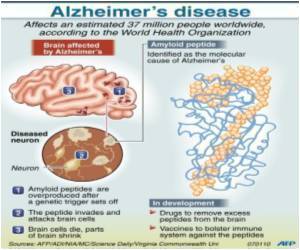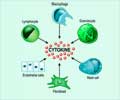Pathological changes in the brain may occur because of the very cells which are supposed to give immunity and protection to the central nervous system.

Tau is a protein found inside of neurons that acts almost like a skeleton, providing a supportive framework for the cell. However, abnormal tau sometimes clumps into filamentous deposits that damage neurons. It is well established that aggregates of microtubule associated protein tau (MAPT) with multiple phosphate groups attached are a defining feature of neurodegenerative disorders called "tauopathies", which include some movement disorders along with Alzheimer's disease and other dementias. Tauopathies are increasingly common neurodegenerative diseases with over 5 million people in the US with AD and millions more affected by non-AD tauopathies.
Previous research suggested a link between inflammation in the nervous system and the tauopathies. More specifically, cells called microglia which play a key role in the immunity of the nervous system have been implicated in the pathogenesis of multiple neurodegenerative disorders. "While some research has suggested a correlative link between neuroinflammation and tauopathies, there is little mechanistic evidence that altered microglial activation plays a pathogenic role in the formation of MAPT pathologies," explains senior study author, Dr. Bruce T. Lamb from the Department of Neurosciences at the Cleveland Clinic.
In order to examine the link between microglia and tauopathy, Dr. Lamb and colleagues studied a specific signaling pathway through which neurons and microglia communicate, fractalkine (CX3CL1), a chemokine expressed in neurons, and its receptor (CX3CR1) which is expressed exclusively in microglia. Dr. Lamb's group evaluated perturbations of this signaling pathway in several different model systems, including a mouse model of inflammation, a mouse model of tauopathy (hTau) and microglia and neurons grown in the laboratory. They found that microglial inflammation promoted MAPT phosphorylation and aggregation in all of the model systems.
"Importantly, introduction of CX3CR1 deficiency into hTau mice resulted in altered microglial activation, enhanced MAPT phosphorylation and aggregation, as well as behavioral abnormalities," says Dr. Lamb. In addition to documenting the effects of a specific microglial receptor on MAPT pathology, the researchers also gained new insight into specific signaling molecules downstream of the CX3CL1/CX3CR1 interaction. Taken together, the findings reveal a direct link between the activation of microglia and the abnormal phosphorylation and aggregation of MAPT in neurons and suggest potential novel therapeutic strategies for tauopathies.
Advertisement











